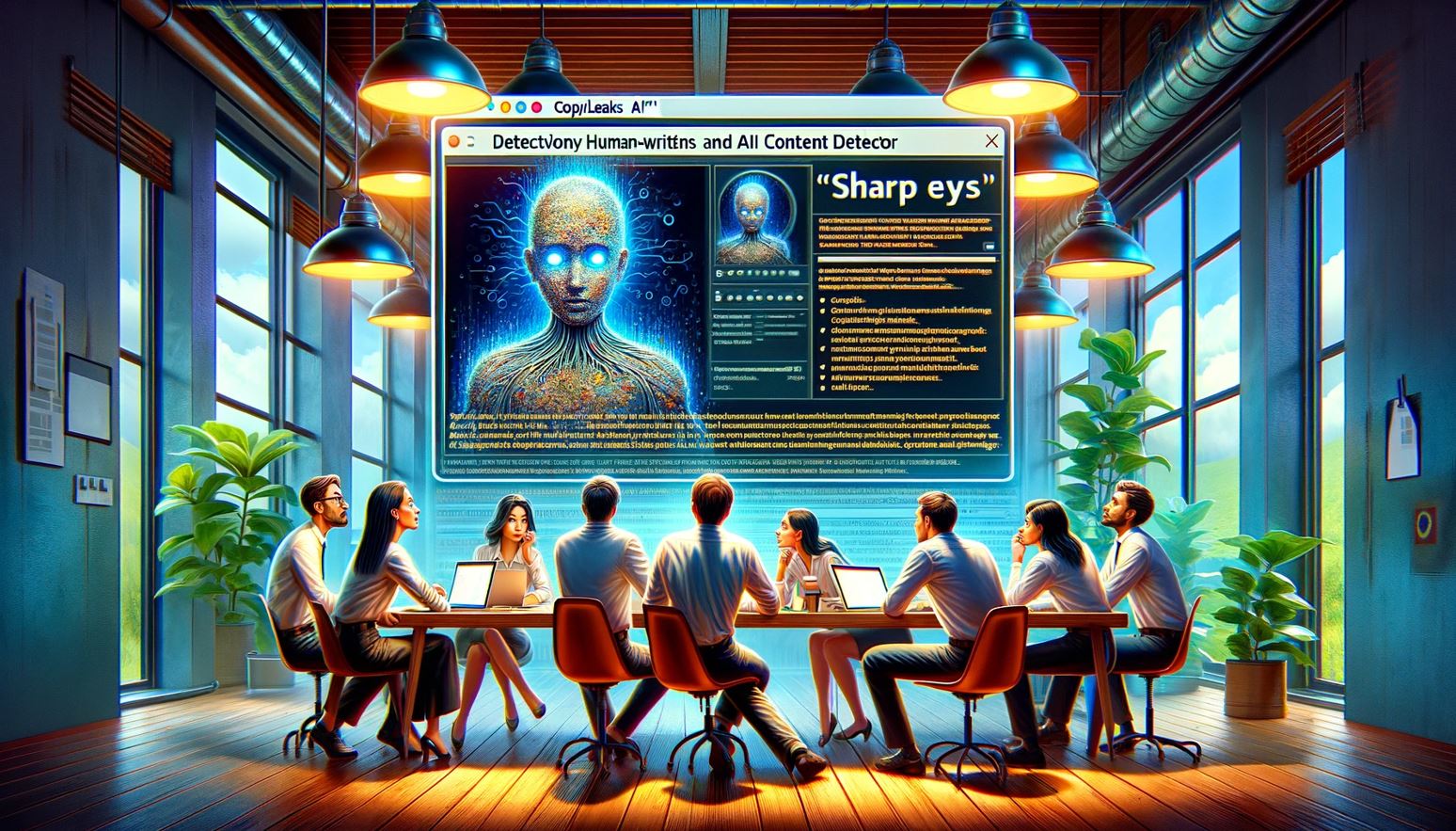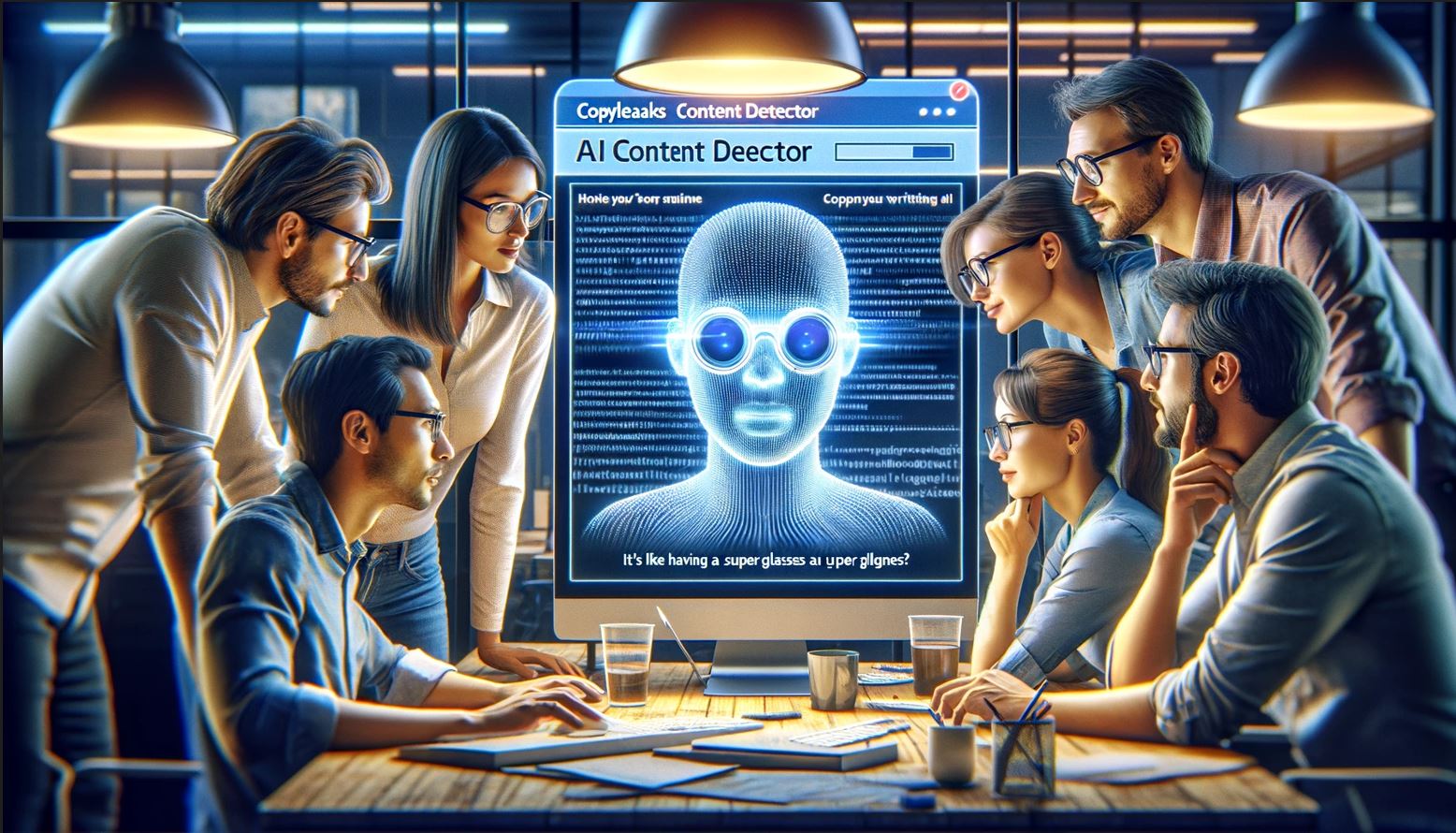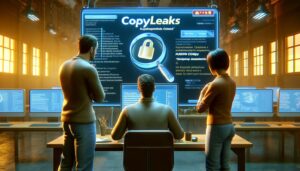Does Copyleaks detect AI? That’s a common question people who are unfamiliar with this tool have been asking.
Are you scratching your head, wondering if that super articulate document or essay was actually penned by a human or cleverly pieced together by an AI?
With the rise of AI-generated text flooding our digital spaces—from academic essays to blog posts—it’s getting tougher to tell.

Try these new AI-powered tools:
- 5 Best AI Detectors To Unmask AI-Written Content With Accuracy
- 5 Best AI Writers To Boost Your Productivity And Content Quality.
- This "Secret AI Writer" Can Bypass AI Detection Like A Pro.
But there’s hope in figuring this all out.
Enter Copyleaks—a tool sharp enough to catch even the slickest AI-crafted words hiding among genuinely human paragraphs.
A bit of a shocker: it turns out Copyleaks has been known to mistakenly flag 4 out of every 10 real-person-written pieces as AI creations. Yikes, right?
Article At-A-Glance
- Copyleaks can find AI-written content with more than 99% accuracy, making hardly any mistakes. It’s been getting better at this for almost ten years.
- This tool checks many languages and knows all about different AI models, even new ones. It spots when just a bit of AI text is mixed in with what people write.
- Copyleaks protects your work safely like a digital fortress and works super fast to check documents.
- You can learn lots by using Copyleaks as a tool, not just for finding copies but to make your writing unique and better.
- Schools and businesses use Copyleaks to make sure work is original, helping students learn honesty in writing and companies keep their words true.
Table Of Contents
Does Copyleaks Detect AI?
Yep, Copyleaks can spot AI! It’s kind of like a detective that knows if a robot or a person wrote something.
Nearly A Decade Of Development
Copyleaks has been on a journey for almost ten years, fine-tuning its abilities to catch AI in the act. Since 2015, they’ve been busy collecting a ton of data. This massive amount of information helps train their AI detection model.
Think of it as feeding a very hungry brain that gets smarter with every bite.
This brain doesn’t just get full. It learns patterns and tricks from the data–like how AI writes versus how we do. Next up, let’s see how Copyleaks uses this smart brain across different AI models.
Coverage Across Various AI Models
So, you’re curious about how Copyleaks keeps up with all those AI models out there? Well, it’s as if you have a secret agent that knows every move of its targets. Think ChatGPT, Gemini, and even the sneaky ones just stepping into the limelight.
This tool doesn’t miss a beat. With tech as sharp as a tack, it spots AI content that tries to blend in or hide behind fancy paraphrasing.
Now imagine this: a new AI model pops up – bam! – Copyleaks is already on it. It’s not just about chasing the big names. Even the newcomers get a spotlight shone on them. The aim? To make sure nothing slips through the cracks.
So whether it’s an essay turned in by a student or an article drafted for publishing, Copyleaks has got coverage from all angles.
With tech savvy enough to detect interspersed AI content.
Unprecedented Speed And Accuracy
Copyleaks dazzles with its speed and precision, checking content faster than you can say “AI detection.” It’s not just quick. It gets things right with a 99.12% accuracy rate. This means nearly every time Copyleaks scans a document, it spots AI-written text without messing up.
Plus, it hardly ever makes mistakes—only misidentifying content as AI-generated about 0.2% of the time.
Whether you’re dealing with English essays or Spanish articles, Copyleaks catches them all with the same high accuracy rate and rapid speed.
This platform uses top-notch technology to find AI content across many languages and formats. Whether you’re dealing with English essays or Spanish articles, Copyleaks catches them all with the same high accuracy rate and rapid speed.
Its power to spot even bits of AI text mixed into human writing sets it apart from others, making sure nothing slips through unnoticed.
Ability To Detect Interspersed AI Content
Finding bits of AI text mixed into real human writing is like finding a needle in a haystack. But guess what? Copyleaks has got some pretty sharp eyes for these needles. This tool can spot when a chunk of text wasn’t written by a person but by a machine instead.
Think of it as having super glasses that see through the tricks AI tries to pull, blending into normal content.
This isn’t just about seeing if an entire document is AI-made or not. We’re talking fine-tuning here. Even if there’s just a smidge of AI text tossed in among lots and lots of human-written words, Copyleaks catches it.
It’s kind of like playing “Where’s Waldo?” but for finding where AI tried to sneak into your paper party uninvited.
Military-Grade Security
So, right after we see how well it spots AI in text, let’s chat about Copyleaks’ defense. This isn’t just any kind of security. We’re talking military-grade stuff here. Imagine having a digital fortress around your work – that’s what Copyleaks offers.
They’ve got GDPR compliance and certifications like SOC 2 and SOC 3. This means they check for weak spots in their system to keep the bad guys out, making sure everything stays safe and sound.
They use top-notch security tech to protect your data from cyber threats. Think of it as having an ultra-strong lock on your front door.
With military-grade encryption, vigilant monitoring, and cutting-edge security features, you can relax knowing your information is guarded by some serious muscle.
These folks are always on the lookout for new ways to beef up their defenses against hackers trying to cause trouble.
Detection Across Multiple Languages
Copyleaks shines bright with its ability to spot AI content in a colorful array of languages. Imagine it as a globetrotting detective who speaks over 100 tongues! From English and Spanish to French, Portuguese, and Arabic, no stone is left unturned.
This multilingual detection prowess means that whether your text dances to the rhythms of Latin beats or flows with the elegance of French poetry, Copyleaks has got you covered.
This impressive language recognition taps into deep text analysis magic. It’s as if you have an eagle-eyed guardian watching over the authenticity of your words across language diversity.
With such cross-language detection skills, Copyleaks ensures that every piece of content—no matter its linguistic dress—is verified for genuine creativity. So yeah, global voices meet their match in keeping it real with Copyleaks.
Knowing The Do’s And Don’ts Of AI Detectors
Jumping into the world of AI detectors can be a bit like exploring a new city – exciting but also a bit tricky. You’ll want to know what to do (like using them to learn) and what not to do (like relying on them too much), so you don’t end up lost.

Using AI Detectors As Learning Tools
AI content detectors do more than just find copied text. They help us learn and get better at making original work. Here’s how we can use these smart tools to grow:
- Spot the differences. These tools can show where AI writing ends and human writing begins. It’s kind of like a game of finding hidden treasures in a sea of words.
- Learn from mistakes. Ever tried to build something new but ended up copying someone else’s idea by mistake? AI detectors point out these Oops! moments, helping us see where we can be more original.
- Feedback loops are gold. Imagine getting advice on how to make your work stand out every time you write. That’s what AI detectors do. They give feedback that helps us tweak and improve.
- Spot-on accuracy means learning the right way. With over 99% accuracy, when an AI detector says something is copied, it probably is. This teaches us to trust the tool and learn how to do better research or cite our sources properly.
- Understand your style. By checking our work with an AI detector, we start seeing patterns in how we write. Maybe we use too many similar phrases or words. Spotting this can help us craft a unique style.
- Know what makes content special. When we see how an AI detector separates common knowledge from unique ideas, it shows us how to add value through our insights or experiences.
- Boost confidence before sharing. Before putting our work out there, running it through an AI detector gives that extra high five that says, “You did good!” It boosts our confidence knowing our work is genuinely ours.
- Handle those tricky bits with ease. Sometimes, we accidentally mirror someone else’s style or ideas without realizing it. An AI tool points this out so we can fix things up and make them shine in our way.
- Turn detective on your own writing. Using these tools lets us play detective on our work, uncovering where we’ve unintentionally borrowed too much from what’s already out there.
- Join a community of learners. Finally, embracing AI detectors as learning tools puts us in a community of people all aiming to create fresh, exciting content that stands tall on its own two feet.
Avoiding Using AI Detectors For Policing
Using AI detectors for policing could cause some issues. It’s better to see them as tools for learning and understanding. Here’s why:
- People often worry about surveillance and losing their privacy. Using these tools like cops might scare folks, making them think every move is being watched.
- Research shows AI detectors can mess up sometimes, marking things as wrong when they’re actually okay. So, if you’re teaching or working with content, don’t just rely on what the tool says.
- AI technology is super smart but not perfect. It learns from examples but can still get confused by tricky words or unique writing styles.
- Ethics matter a lot here. Think about fairness and kindness before using a tool to catch mistakes or problems.
- Trust is key, especially in places like schools or companies. If people feel they’re always under a microscope, trust goes out the window.
- Imagine finding out a computer marked your hard work as wrong because it didn’t understand your style or idea? That’d be pretty frustrating.
- Finally, there’s something cool about learning from errors and growing. Machines pointing out every mistake might take that chance away from us.
Seeing these points, it seems better to use AI for help rather than strict rule enforcement!
Understanding The Potential For False Positives
So, moving right from the idea of not using AI detectors as the end-all for judgment calls, we get to a slightly tricky situation – false positives. It’s this sneaky thing where a person’s work gets tagged as machine-made when it’s actually human-crafted.
Oops! The chance sits at just 0.2%, but yep, it happens. Even with top-notch tools like Copyleaks that are on the lookout for AI fingerprints in writing, sometimes they get it wrong.
Imagine you poured your heart into an essay only to have it called out as AI-generated — kind of a bummer, right? This mix-up isn’t about the machine doubting your creativity. Rather, it’s just part of dealing with smart tech.
While accuracy is high and error rates low (thanks to loads of text analysis), no system is perfect.
So whether you’re teaching machines or learning from them, understanding that small gap where errors might slip through keeps expectations real and helps everyone focus on how awesome these tools can be for spotting faux content without sweating the small stuff.
Setting Clear Expectations
Knowing how to use AI tools the right way matters a lot. We need rules for using AI detectors well. It’s all about balancing what we expect from these tools and what they can actually do.
Even though AI detectors like Copyleaks are really good, they’re not perfect. They have a success rate of over 99%, but mistakes can still happen.
We should think about these things before starting to use AI. This means being smart about their limits and knowing that sometimes, they might get things wrong. Using them responsibly is key.
Next up, let’s talk about different ways people are using Copyleaks to catch AI-made content.
Use Cases For Copyleaks AI Content Detection
Finding out where Copyleaks shines isn’t just about the tech stuff. It’s about seeing it in action, from schools keeping things honest to companies making sure their words are truly theirs.
AI Model Training
Training AI models is like teaching a new language to a computer. Copyleaks uses loads of texts—both from humans and computers—to show the AI what’s what. Think of it as a big library where the AI goes to learn the difference between human-made stories and ones spun by machines.
This way, Copyleaks makes sure its detectors know exactly how to spot when something wasn’t written by a person.
This method mixes smart machine work with human smarts for top-notch detection. It’s all about making sure the training data is good so that the AI can really understand natural language processing and text analysis.
Plus, this helps in keeping everything from academic work to web content real and honest, just how we like it!
Ensuring Academic Integrity
Making sure students write their own work is key. Copyleaks comes in handy for this. Teachers use it to check if assignments are original or not. It can spot when someone copies from a book or uses words that AI made up.
The goal is to keep schoolwork fair and honest.
Schools like using tools that help teachers find out if the work is really done by students. This keeps everyone on the same page about being honest in school.
Also, Edmentum teamed up with Copyleaks so teachers have a better way to see if work is copied or made by AI.
Next up, let’s talk about how people actually use Copyleaks for different things.
Governing Content Creation And Publishing
Governing content creation and publishing is key when using Copyleaks AI Content Detector. This tool checks if what you want to put out there was made by a person or a machine. It’s all about making sure your work is genuine and sticks to the rules of where it will be shared.
The AI detection model that Copyleaks uses has been learning from loads of data since 2015. So, it’s pretty smart at spotting if something wasn’t written by human hands.
For folks putting together articles, reports, or any other kind of workplace content, having this detector on their side means they can share their work with confidence. They know that everything meets high standards for originality and authenticity.
This way, whether you’re writing up something new or checking over someone else’s piece, the technology backs you up in keeping things real and trustworthy across languages and styles.
Impact On Campaign KPIs
Using Copyleaks AI Content Detector keeps your campaign’s content fresh and original. This means you avoid copyright trouble and plagiarism, which can hurt your reputation. Your campaigns then perform better because they use unique content that stands out.
Ensuring your content is authentic helps meet the goals set for key performance indicators (KPIs). It proves to everyone that what you create is yours alone, boosting trust in your brand or message.
This focus on originality aids in validating the integrity of your campaign contributions, safeguarding intellectual property every step of the way.
Comparing Copyleaks To Other AI Content Detection Platforms
So, how does Copyleaks stack up against its rivals in the AI detecting arena? You might be surprised to see it’s not just about who finds more “copy-paste” stuff. It’s a whole game of speed, smarts, and keeping things tighter than Fort Knox.

Accuracy
Copyleaks beats other platforms with its accuracy in finding AI content. It has a 99.1% overall accuracy rate, which is pretty amazing. Plus, it only gets things wrong about 0.2% of the time – that’s the lowest mistake rate out there!
People from all over have done studies and found Copyleaks to be top-notch when it comes to quickly and accurately spotting AI-generated text.
People from all over have done studies and found Copyleaks to be top-notch when it comes to quickly and accurately spotting AI-generated text.
This tool is like having an eagle eye for AI words mixed into regular text, across different languages too. Whether you’re comparing notes or just curious, these numbers are hard to ignore.
Copyleaks really knows its stuff when lining up against the competition in terms of precision and getting it right almost every single time.
Advantages Of Copyleaks
Talking about accuracy brings us straight to the strengths that make Copyleaks stand out. It’s not just about catching the sneaky AI-written content.
It’s how Copyleaks does it that really turns heads. Here’s the scoop on why people are all thumbs up about it:
- Speed and ease are the names of the game. With Copyleaks, you get your results fast and without having to jump through hoops. This means more time for coffee breaks, folks.
- This tool isn’t just good. It’s top-notch according to a third-party study. Yep, you heard that right. It grabbed the gold medal for being the most accurate AI text detector out there.
- You don’t need to break your piggy bank to access its services. That’s right – users can dive into this AI detection magic for free. Now, who doesn’t love freebies?
- Let’s talk security because Copyleaks didn’t come to play games here either. They’re offering military-grade protection so that your content stays under lock and key.
- Worried about false alarms? Don’t be! While no system is perfect, Copyleaks has fine-tuned its ability to spot AI content with minimal fuss over mistakes.
- Speaking of coverage, this platform understands homework like no other – detecting AI-generated stuff in multiple languages!
- And lastly, let’s not forget reliability. Users from all corners trust Copyleaks with their eyes closed because they know this platform delivers what it promises.
So there you have it — a basket full of reasons why Copyleaks is shaking up the content detection scene like no other!
Limitations Of Other Platforms
So, after singing praises about Copyleaks’ superpowers, it’s only fair we chat about where other platforms might stumble a bit.
Trust me, it’s not all sunshine and rainbows out there in the world of AI content detection. Here’s what you need to know:
- Accuracy isn’t always on point. In the land of detecting AI-generated content, hitting the bullseye is key. But, alas, some platforms are shooting arrows in the dark. Their aim? Questionable at best.
- They often miss the mark with language diversity. Imagine trying to detect a sneaky piece of AI text that’s not in English but in another language. Some platforms just shrug and say, “Sorry, can’t help.”
- Speed? More like a slow-motion replay. Waiting for results can feel like watching paint dry or grass grow — painfully slow.
- Security could be tighter than an over-packed suitcase. We’re talking sensitive info here. You don’t want it leaking out or ending up in the wrong hands.
- Spotting interspersed AI content is like finding a needle in a haystack for them. If it’s not all AI or all human-written but a mix? Good luck getting accurate results.
- False alarms ring louder than necessary sometimes. Ever get accused of something you didn’t do? Yeah, these platforms might pin something on your perfectly original work by mistake.
- Limited coverage feels like showing up to a potluck with just a spoon — underprepared much? Some tools only focus on certain types of content or industries.
- Setting clear expectations turns into setting up for disappointment with these tools sometimes — envision expecting fireworks but getting sparklers instead.
- Case studies are few and far between. Finding solid success stories can be like searching for treasure without a map.
- Language support often stops short of truly global reach, so if your content straddles linguistic lines, cross your fingers and hope for the best.
Sure, no one’s perfect and every tool has its quirks and features (or lack thereof). But knowing these limitations could save you from hitching your wagon to a falling star — or at least from expecting too much from some AI detection buddies out there!
Copyleaks Detects AI For Cleaner, Safer Writing
Copyleaks shines in spotting AI text, with years of development and wide model coverage. It’s quick and sharp, even catching mixed-in AI words. This tool is safe as a vault and works with many languages.
Think about using it wisely—more like a guide than a strict rulebook. If you’re into keeping content clean or want to know more about AI detection, give Copyleaks a try.
With its solid track record, you just might find what you’re looking for—and who knows? You could be part of shaping how we handle new tech writing challenges!
FAQs
1. Can Copyleaks find out if my paper was written by AI?
Yes, Copyleaks can tell if your work is done by AI.
2. Will using AI to write my homework get caught by Copyleaks?
Yep, using AI for homework will likely get spotted by Copyleaks.
3. Does Copyleaks only detect AI or other types of cheating too?
Copyleaks finds all sorts of cheating, not just the AI kind.
4. How good is Copyleaks at catching AI-written texts?
Copyleaks is pretty sharp at catching texts written by AI.
5. If I tweak an AI-written essay a bit, will Copyleaks still catch it?
Even with tweaks, there’s a good chance that Copyleaks will catch an AI-written essay.
Meet our resident tech wizard, Steve the AI Guy. Now, before you get any wild ideas, let’s clear up one thing – he’s 100% human! I mean, he’s got the work history to prove it. He spent a decade diving into the deep end of the tech industry doing business intelligence work, splashing around with two of the world’s largest business consulting companies, Deloitte and Ernst & Young. Learn More










